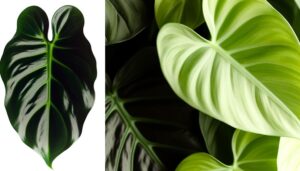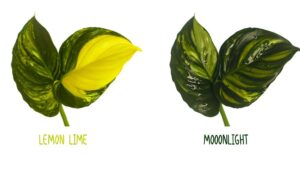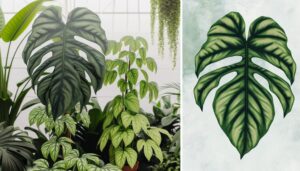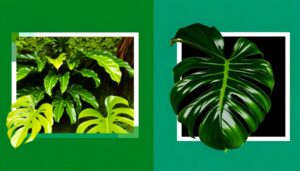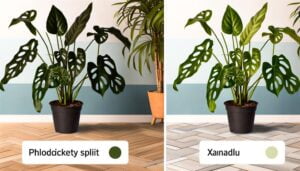Philodendron Atabapoense Vs Billietiae: A Comparison!
Philodendron atabapoense and Philodendron billietiae, both members of the Araceae family, differ significantly in morphology and ecology. P.
atabapoense features elongated, lanceolate leaves with velvety deep green and maroon hues, and exhibits vining growth habits. In contrast, P.
billietiae displays broader, sagittate leaves with leathery textures and yellowish-green adaxial surfaces, growing semi-climbing with thicker stems and pronounced petioles. These species require distinct light conditions, with P.
atabapoense favoring bright, indirect light, while P. billietiae thrives in moderate to high indirect light.
Each plant’s unique adaptive traits make them fascinating subjects for further exploration.

Comparison of Philodendron Atabapoense and Philodendron Billietiae
| Characteristic | Philodendron Atabapoense | Philodendron Billietiae |
|---|---|---|
| Leaf Shape | Arrow-like, more violin/cello shaped | More elongated, broader leaf shape |
| Leaf Color | Dark green with purple-burgundy undersides | Dark green with lighter green or yellowish undersides |
| Leaf Texture | Slightly glossy | Glossy |
| Mature Leaf Size | Can grow larger, typically wider | Smaller compared to Atabapoense |
| Growth Habit | Climbing | Climbing |
| Native Region | Amazon rainforest, particularly in Venezuela | Colombia, particularly in the Amazon |
| Rarity | Less common in cultivation | More commonly available in the market |
Origins and Background
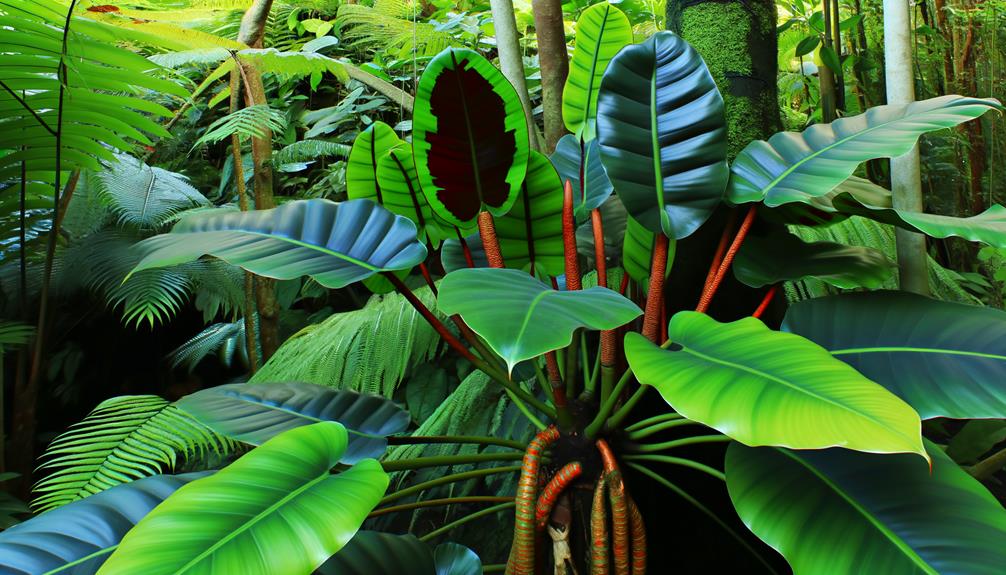
The Philodendron atabapoense and Philodendron billietiae, both belonging to the Araceae family, originate from distinct regions within tropical South America, exhibiting unique morphological and ecological adaptations.
Philodendron atabapoense is primarily found in the humid, lowland forests of Venezuela, particularly in the Orinoco River Basin. It thrives in wet, shaded environments, contributing to its specialized epiphytic growth habit.
Conversely, Philodendron billietiae is native to the tropical rainforests of French Guiana and Brazil. This species is characterized by its preference for slightly higher elevations and well-drained soils.
Both species demonstrate remarkable adaptability to their respective habitats, underscoring their evolutionary divergence within the Philodendron genus. Their distinct geographical distributions reflect their varied ecological niches and adaptive traits.
Leaf Shape and Size
Characterized by distinct morphological traits, the leaves of Philodendron atabapoense and Philodendron billietiae exhibit notable differences in both shape and size.
Philodendron atabapoense features elongated, lanceolate leaves that can reach lengths of up to 60 centimeters, presenting a more streamlined and narrow appearance.
In contrast, Philodendron billietiae showcases broader, sagittate leaves that can grow up to 90 centimeters in length, with pronounced lobes that give a heart-shaped, almost arrow-like configuration.
The petioles of P. billietiae are comparatively longer and sturdier, supporting its larger leaf structure, whereas P. atabapoense has shorter, more delicate petioles.
These taxonomic distinctions in leaf morphology are essential for accurate identification and understanding of each species’ unique ecological adaptations.
Color and Texture
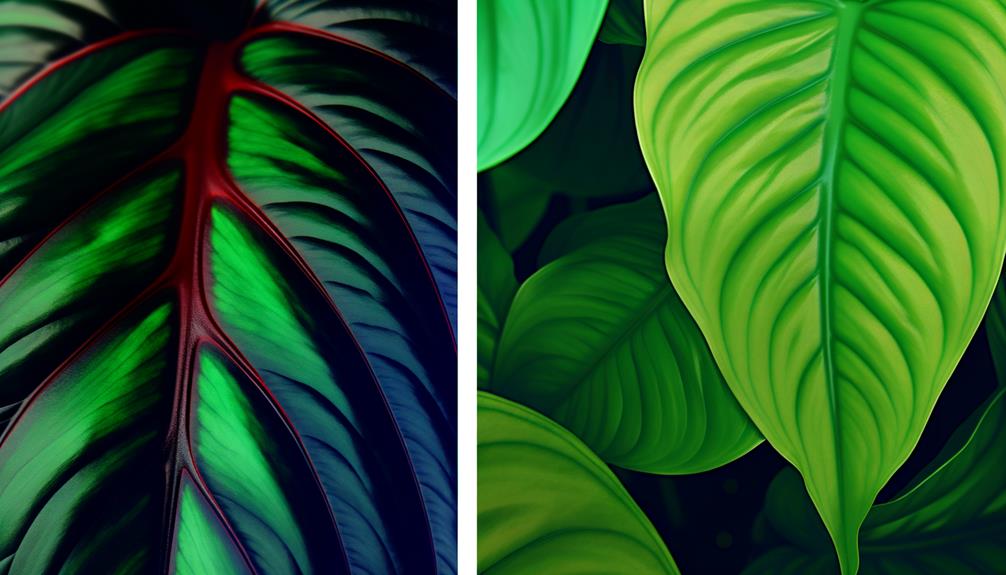
Observing the foliage of Philodendron atabapoense and Philodendron billietiae reveals distinct differences in coloration and leaf texture that are critical for taxonomic differentiation.
Philodendron atabapoense exhibits a deep green adaxial leaf surface, shifting to a rich maroon abaxial side. Its leaves possess a smooth, somewhat velvety texture.
In contrast, Philodendron billietiae features a lighter green adaxial surface with a less pronounced, often yellowish-green abaxial side. The texture of P. billietiae’s leaves is noticeably more coriaceous, with a thicker and leathery feel.
These variations in color and texture not only aid in species identification but also reflect the ecological adaptations of each plant, contributing to their unique morphological characteristics within the Philodendron genus.
Growth Habit
Philodendron atabapoense demonstrates a vining growth habit, producing elongated stems that exhibit notable climbing tendencies. This species employs aerial roots to anchor itself to supportive structures, facilitating vertical growth.
In contrast, Philodendron billietiae exhibits a more self-supporting, semi-climbing growth pattern with thicker stems and prominent petioles. The morphological distinctions between these two species are significant for understanding their respective ecological adaptations and cultivation requirements.
| Characteristic | Philodendron atabapoense | Philodendron billietiae |
|---|---|---|
| Growth Habit | Vining | Semi-climbing |
| Stem Structure | Elongated, slender | Thicker, sturdier |
| Climbing Mechanism | Aerial roots | Limited aerial roots |
| Petiole Prominence | Moderate | Pronounced |
| Vertical Support | Requires | Partially self-supporting |
These growth habits influence their placement in horticultural designs and necessitate different support structures.
Light Requirements
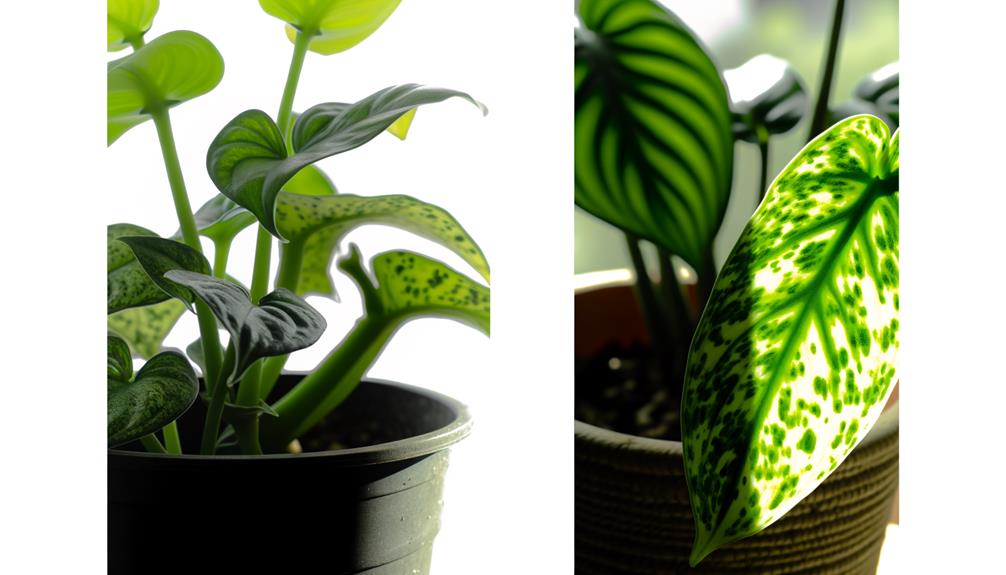
Ideal light conditions for Philodendron atabapoense and Philodendron billietiae are crucial for their physiological health and growth performance. Both species, native to tropical rainforests, exhibit a preference for environments with filtered sunlight.
Direct sunlight can lead to photodamage, whereas insufficient light may result in etiolation and compromised structural integrity.
- Philodendron atabapoense: Prefers bright, indirect light.
- Philodendron billietiae: Thrives under moderate to high indirect light.
- Best Placement: Near east or west-facing windows with sheer curtains.
- Artificial Lighting: Fluorescent grow lights can supplement natural light.
- Light Duration: Approximately 10-12 hours of light per day for best photosynthetic activity.
Understanding these light requirements guarantees the maintenance of healthy, vigorous growth in both species.
Watering Needs
The Philodendron Atabapoense and Philodendron Billietiae exhibit distinct watering needs that reflect their unique physiological and ecological adaptations.
Best moisture levels for each species vary, requiring customized irrigation frequencies to prevent root rot and promote vigorous growth.
Additionally, their drainage requirements must be carefully managed to replicate natural habitats and encourage aeration within the root zone.
Optimal Moisture Levels
Both Philodendron atabapoense and Philodendron billietiae exhibit specific moisture requirements that must be closely monitored to achieve peak growth and health. These species thrive in environments where soil moisture levels mimic their natural tropical habitats.
Maintaining ideal moisture conditions involves several critical considerations:
- Soil Type: Utilize well-draining, aerated substrates to prevent waterlogging.
- Humidity: Maintain ambient humidity levels between 60-80% to support physiological processes.
- Soil Moisture: Ensure consistently moist soil without oversaturation.
- Water Quality: Use distilled or rainwater to avoid mineral buildup.
- Drainage: Pots should have adequate drainage holes to prevent root rot.
Adhering to these guidelines will promote strong growth and vibrant foliage, maximizing the ornamental appeal and health of both Philodendron atabapoense and Philodendron billietiae.
Frequency of Watering
Determining the appropriate watering frequency for Philodendron atabapoense and Philodendron billietiae involves monitoring soil moisture levels and environmental conditions to prevent both dehydration and waterlogging.
Philodendron atabapoense, native to humid tropical regions, generally requires more frequent watering, ideally when the top 2-3 inches of soil become dry.
Conversely, Philodendron billietiae, though also tropical, thrives with slightly less frequent watering, necessitating intervention when the top inch of soil dries out.
Both species benefit from water applied directly to the soil, avoiding foliage to reduce the risk of fungal infections.
Observing leaf turgidity and color changes can offer additional cues; wilting or yellowing may indicate improper watering, necessitating adjustments to the regimen.
Drainage Requirements
Proper drainage is paramount for Philodendron atabapoense and Philodendron billietiae, necessitating well-aerated soil that facilitates efficient water percolation to prevent root rot. Both species thrive in substrates that support rapid drainage while retaining adequate moisture.
Their natural epiphytic habitats underscore the importance of avoiding waterlogged conditions that can lead to detrimental root diseases. Essential practices include selecting appropriate potting media and ensuring container drainage.
- Soil Composition: Utilize a mix of orchid bark, perlite, and peat moss.
- Container Choice: Opt for pots with multiple drainage holes.
- Watering Practices: Allow the top 2 inches of soil to dry before re-watering.
- Root Health Monitoring: Regularly check for signs of root rot.
- Humidity Control: Maintain moderate to high humidity without oversaturation.
Soil and Potting Mix
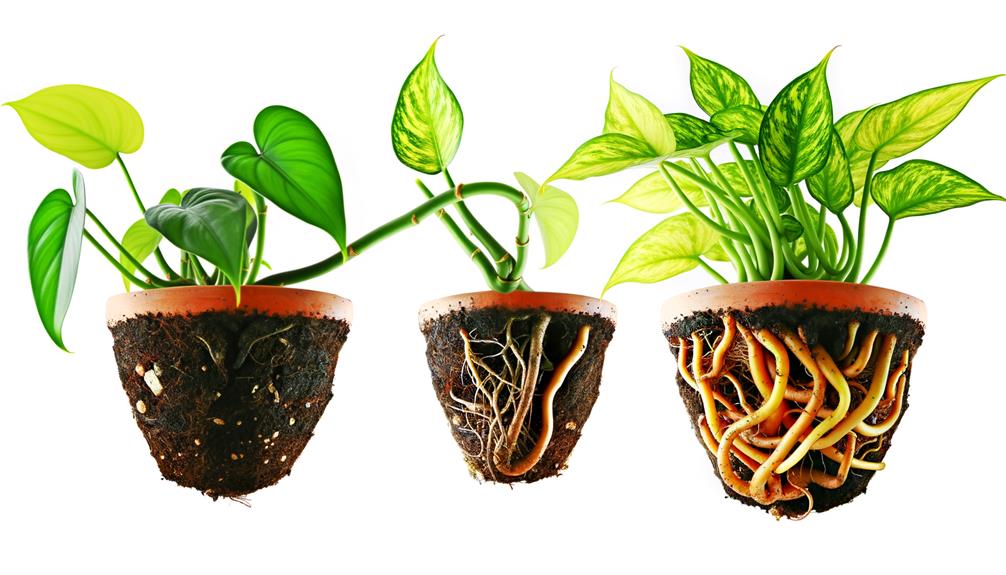
Regarding soil composition, Philodendron Atabapoense and Billietiae both thrive in a well-draining, aerated potting mix rich in organic matter. This promotes optimal root respiration and prevents waterlogging, which can be harmful to these aroids.
An ideal mix includes components such as peat moss, perlite, and orchid bark, which collectively maintain moisture while facilitating drainage.
| Component | Function |
|---|---|
| Peat Moss | Retains moisture and nutrients |
| Perlite | Enhances aeration and drainage |
| Orchid Bark | Provides structure and aeration |
Both species exhibit enhanced growth in substrates that mimic their natural epiphytic habitats, underscoring the importance of a mix that balances water retention with porosity. This balance is essential for promoting healthy root development and preventing root rot.
Temperature and Humidity
Both Philodendron Atabapoense and Billietiae thrive in a controlled environment where temperatures range from 65°F to 80°F (18°C to 27°C) and humidity levels consistently exceed 60%. These conditions mimic their native tropical habitats, thereby optimizing physiological processes such as photosynthesis and transpiration.
Key environmental factors include:
- Temperature Stability: Avoid fluctuations to prevent stress responses.
- High Humidity: Maintain levels above 60% for optimal stomatal function.
- Good Air Circulation: Prevents fungal growth while maintaining humidity.
- Indirect Light: Ensures photosynthetic efficiency without leaf scorch.
- Regular Monitoring: Use hygrometers and thermometers for precision.
These parameters optimize both species to achieve vigorous growth and robust foliage. Understanding these requirements is essential for successful cultivation in non-native environments.
Pest and Disease Resistance
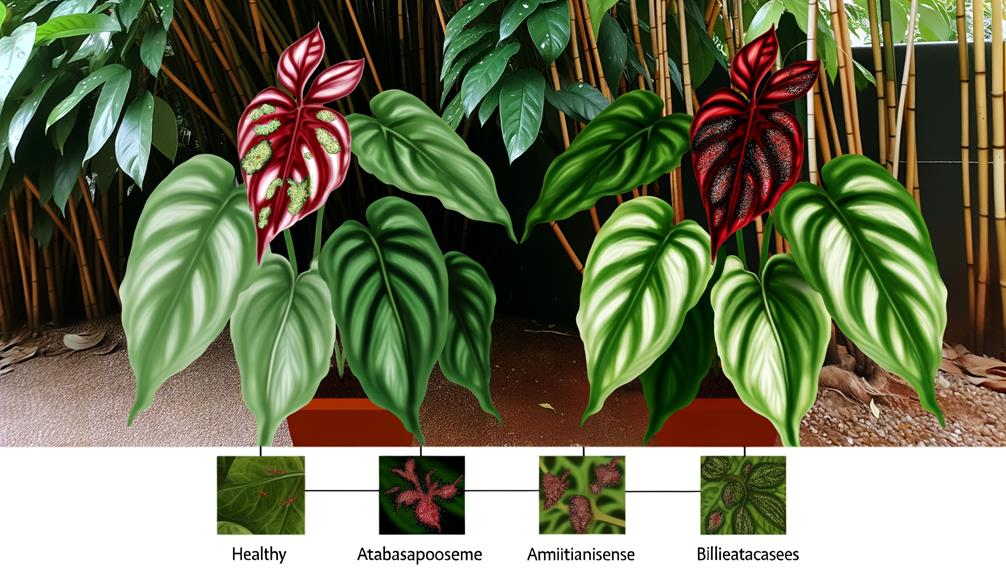
While maintaining ideal environmental conditions is fundamental for the growth of Philodendron Atabapoense and Billietiae, understanding their pest and disease resistance is equally critical to promote plant health and longevity.
Philodendron Atabapoense exhibits moderate resistance to common pests such as aphids and spider mites, likely due to its sturdy leaf structure and secondary metabolites.
Conversely, Billietiae, although structurally similar, tends to be more susceptible to mealybugs and scale insects. Both species can suffer from bacterial and fungal infections, particularly in high-humidity environments.
Implementing preventative measures, such as proper sanitation and vigilant monitoring, can mitigate these risks. Additionally, employing biological controls and systemic insecticides may enhance their resistance, ensuring efficient growth and development.
Conclusion
In comparing Philodendron atabapoense and Philodendron billietiae, significant distinctions emerge in leaf morphology, chromatic attributes, and growth patterns. Both species exhibit unique adaptations to their native environments, yet they diverge in light preferences, hydration requirements, and resilience to pests.
Understanding these differences aids in optimizing cultivation practices, ensuring plant health, and enhancing aesthetic appeal. The study of these philodendrons not only enriches botanical knowledge but also contributes to the broader field of horticultural science.

